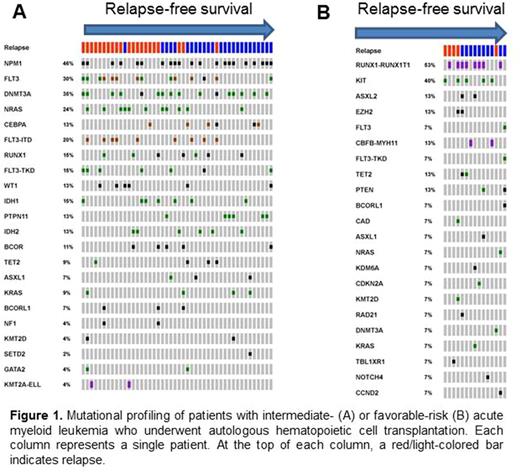Abstract
BACKGROUND: The use of autologous hematopoietic cell transplantation (autoHCT) as post-remission therapy for acute myeloid leukemia (AML) has become increasingly infrequent, both because of an expanding pool of donors for allogeneic hematopoietic cell transplantation (alloHCT) and because of the unclear benefit of autoHCT over conventional consolidation chemotherapy. Since most trials of autoHCT for AML were performed in an era prior to routine molecular testing at diagnosis, little is known about the impact of recurrent genetic mutations on outcome of autoHCT for AML, and in particular the impact of mutations other than FLT3-ITD, NPM1, and CEBPA. We retrospectively used next-generation sequencing for >400 cancer-related genes to evaluate diagnostic samples of patients (pts) with both intermediate- (int) and favorable- (fav) risk AML who underwent autoHCT, and correlated these findings with clinical outcome.
METHODS: Eligible pts included adults with non-M3 fav- or int-risk AML who underwent autoHCT at the University of California, San Francisco and had available diagnostic bone marrow specimens from which DNA was successfully extracted. Pts were excluded from analysis if they remained relapse-free with <1 year of follow-up available. Mutational profiling via next-generation sequencing was performed via either the Foundation One Heme (n=35) or UCSF 500 (n=28) sequencing platforms. Mutations occurring at a frequency of ≤3% were excluded from analysis.
RESULTS: Of 61 patients with available diagnostic material and successful DNA extraction, 46 had int-risk and 15 had fav-risk AML. Median age at transplant was 47 years (range 20 - 69) and 38% were male. Median follow-up for this cohort was 3.4 years (range 0.3 - 16.3). For the int-risk cohort, median relapse-free survival (RFS) was not reached (range 0.2 - 16.3), with 25/46 pts (54%) remaining relapse-free. For the fav-risk cohort, median RFS was also not reached (range 0.2 - 9.6), with 10/15 pts (67%) remaining relapse-free. All but 1 pt (98%) had ≥ 1 detectable somatic mutation, with an average of 3.1 somatic mutations per pt in the int-risk cohort and 2.5 somatic mutations per pt in the fav-risk cohort.
In the int-risk group, the most commonly mutated genes were NPM1 (21/46; 46% of pts), DNMT3A (16/46; 35%), IDH1/2 (13/46; 28%), NRAS (11/46; 24%) and FLT3-ITD (9/46; 20%) (Figure 1A). Fifty-two percent of pts harbored mutations in either NPM1 and/or FLT3-ITD. Only 4/15 (27%) patients with mutated NPM1 (NPM1mut) and wild-type FLT3-ITD (FLT3-ITDwt) relapsed. Of the 4 NPM1mut/FLT3-ITDwt pts who relapsed, all had co-occurring DNMT3A mutations and 2 had both co-occurring FLT3-TKD and IDH1 mutations. Of pts with FLT3-ITDmut, 6/9 (67%) relapsed. Of the 3 FLT3-ITDmut pts who did not relapse, 2 had co-occurring mutations in IDH1 and the other had a co-occurring FLT3-TKD mutation. The only mutation 100% predictive for non-relapse was PTPN11 (n=6), although it co-occurred with NPM1mut in 5 of 6 cases and never co-occurred with FLT3-ITDmut. In the cohort of pts with wild-type NPM1/FLT3-ITD/CEBPA (n=18), 2/2 (100%) with KMT2A-ELL fusions, 3/5 (60%) with RUNX1mut, 3/4 (75%) with IDH1/2 (2 of which co-occurred with RUNX1 mutations), and 1/4 (25%) with NRASmut relapsed. Overall 7 of the 18 (39%) remain relapse-free.
In the fav-risk group, KIT mutations were detected in 5/15 (33%) pts, 3 of whom (60%) remain relapse-free (Figure 1B). The next most frequently mutated genes were ASXL2, EZH2, TET2, and PTEN, each present in 2/15 (13%) pts. Of the 3 pts who relapsed in the absence of a KIT mutation, 1 harbored a DNMT3A mutation, 1 harbored a mutation in TBL1XR1, and 1 had no detectable somatic mutations. Three of the 5 pts who relapsed were ≥ 60 years old.
CONCLUSIONS: Comprehensive genomic profiling may aid risk-adapted decision-making in the management of pts with int- and fav-risk AML considered for autoHCT. In our cohort-similar to conventional consolidation chemotherapy-mutations in FLT3-ITD, NPM1, and CEBPA were the strongest predictors of outcome. The presence of PTPN11 mutations in int-risk AML appears to strongly predict long-term RFS after autoHCT. In a small cohort of fav-risk AML patients, the adverse prognosis of a KIT mutation was overcome by autoHCT in 60% of pts.
Mannis: Amgen: Honoraria; Juno: Research Funding; Curis: Honoraria; Agios: Research Funding. Zhong: Foundation Medicine: Employment. He: Foundation Medicine, Inc: Employment, Other: Stock. Nahas: Foundation Medicine inc: Employment, Other: stockholder. Andreadis: Cellerant Therapeutics: Research Funding; Novartis Pharmaceuticals Corporation: Honoraria, Research Funding; Incyte Pharmaceuticals: Research Funding; Genentech Inc.: Employment, Equity Ownership, Honoraria; Astellas: Honoraria; Amgen: Research Funding; Gilead Sciences: Honoraria; Pharmacyclics: Research Funding; Seattle Genetics: Honoraria. Mughal: Foundation Medicine, Inc: Employment, Other: Stock. Logan: Astellas: Research Funding; Shire: Consultancy; Amgen: Consultancy; Novartis: Consultancy, Research Funding; Pharmacyclics: Research Funding; Jazz: Consultancy; Kite: Research Funding; Incyte: Consultancy.
Author notes
Asterisk with author names denotes non-ASH members.


This feature is available to Subscribers Only
Sign In or Create an Account Close Modal